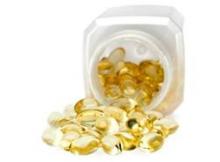VIENNA – Pooled analysis of data from three controlled trials provides further evidence to support the use of vitamin E in the treatment of nonalcoholic steatohepatitis (NASH).
Daily vitamin E intake led to resolution of NASH in a higher percentage of patients than in those not treated with vitamin E (38% vs. 20%, P < .001). It also resulted in more patients achieving histologic improvement of NASH (45% vs. 22%, P < .0001).
“The magnitude of the effect of vitamin E on NASH was comparable to pioglitazone, metformin, and obeticholic acid,” Dr. Kris Kowdley of the Swedish Medical Center, Seattle, said in an interview at the meeting sponsored by the European Association for the Study of the Liver.
The odds ratio (OR) for the resolution of NASH for vitamin E versus no vitamin E was 2.4, (P < .001) and ORs for the other anti-NASH treatments used in the trials were 3.4 for pioglitazone vs. placebo (P = .001), 1.8 for metformin vs. placebo (P = .24), and 1.8 for obeticholic acid vs. placebo (P = .13).
The respective ORs for histologic improvement for vitamin E and the other treatments were 2.9 (P < .0001), 4.1 (P = .0001), 2.7 (P = .02), and 3.1 (P = .0002).
The data combined for the analysis were derived from three controlled studies: PIVENS (Pioglitazone Versus Vitamin E versus Placebo for the Treatment of Nondiabetic Patients with Nonalcoholic Steatohepatitis], TONIC (The Treatment of Nonalcoholic Fatty Liver Disease in Children), and FLINT (Farnesoid X Receptor Ligand Obeticholic Acid in NASH Treatment Trial).
In the phase III, randomized, placebo-controlled, double-blind PIVENS trial, vitamin E therapy was compared to pioglitazone and placebo in 247 nondiabetic adults (N. Engl. J. Med. 2010; 362:1675-85).
In the TONIC phase III, double-blind, placebo-controlled trial, 173 children with NASH but no diabetes were randomized to treatment with vitamin E, metformin, or placebo for 96 weeks.
In FLINT, a phase II, placebo-controlled, double-blind trial of obeticholic acid, vitamin E was allowed as a concomitant therapy, and 23% of placebo-treated patients took vitamin E at baseline.
Dr. Kowdley noted that natural (d-alpha-tocopherol) not synthetic vitamin E was used in all these trials and the dosage used was 800 IU once daily in the PIVENS trial, 400 IU twice daily in the TONIC trial, and 400-800 IU in the patients who received it in the placebo arm of the FLINT trial.
In total, the pooled analysis considered 347 participants of these trials of whom 155 had been treated with vitamin E and 192 had not.
Histologic improvement was defined as at least a 2-point improvement in NASH with no worsening of fibrosis. NASH resolution was determined by pre- and posttreatment biopsies.
How vitamin E might be exerting its effect is not clear, Dr. Kowdley said. “We know that from the PIVENS trial it does not affect insulin sensitivity, and so presumably it has an antioxidant effect,” he speculated. Combination with other anti-NASH treatments, such as obeticholic acid, could produce synergistic effects perhaps, he acknowledged, but that would require further study.
“Vitamin E appears to be safe in this short-term study,” Dr. Kowdley said. Safety measures included the incidence of cardiac events and changes in lipid levels. However, there was no increased incidence in cardiovascular events with vitamin E use compared to no vitamin E use (6.9% vs. 7.6%, P =.85). There were also no significant differences in net changes in total cholesterol, high-density lipoprotein cholesterol, low-density lipoprotein cholesterol, or triglycerides.
Although it was not shown in the late-breaking poster, Dr. Kowdley said that vitamin E appeared to improve NASH in diabetic as well as in nondiabetic subjects with no increased risk of cardiovascular events as other studies have suggested.
“It’s a pooled analysis,” Dr. Kowdley acknowledged, “but we conclude that vitamin E was significantly associated with histologic improvement, reduction in NASH activity score and resolution of NASH, with an effect size that seems in the ballpark of the other therapies.
“So I think this suggests that vitamin E should be our toolkit for treatment of NASH,” he added.
The National Institute of Diabetes and Digestive and Kidney Diseases sponsored the studies. Dr. Kowdley had no relevant conflicts of interest to disclosure.

